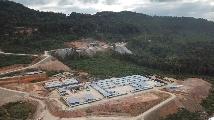SIEM REAP, Cambodia, Jan. 15 (Xinhua) -- Sak Ema, a souvenir vendor at an Old Market's stall here in the country's tourist hub, has recorded better sales after the Chinese-invested Siem Reap Angkor International Airport (SAI) launched its operations last November.
Selling a variety of souvenirs ranging from Angkor-pictured plates, sculptures and paintings to clothes and traditional scarves, Ema notices that her sales have recently surged by about 50 percent on normal days and doubled on festival days or holidays.
"Currently, sales are good, much better than during the COVID-19 period," she told Xinhua in a recent interview. "I make about 100 U.S. dollars in revenue a day, and during festivals, revenue is up to 200 dollars a day."
The 33-year-old vendor believed that the SAI has helped attract more international airlines and tourists to Siem Reap province, home to the UNESCO-listed Angkor Archaeological Park.
"I hope more foreign tourists will come to visit Cambodia because with the new airport, passengers can fly directly to Siem Reap province," she said. "When there are more tourists, vendors like us are very happy."
Ema said she is eager to see the mass return of Chinese holiday-makers, saying that they are big spenders for souvenirs.
Lann Sophat, a Korean-speaking tour guide at the Angkor Archaeological Park, said the new airport has brought more travelers to Siem Reap, helping revitalize tourism-related businesses in the province.
"Now, a lot of hotels and guesthouses have re-opened thanks to the growing number of tourists to the Angkor Wat temple," he told Xinhua. "For Chinese tourists, I have noticed that there has been a gradual rise in numbers after the COVID-19 has been under control."
The tour guide is confident that the recent launch of the 2024 Cambodia-China people-to-people exchange year will be another driving force for tourism growth in Cambodia, particularly in Siem Reap.
Tes Vongsak, a tuk-tuk driver, who usually carries tourists to sightsee centuries-old temples in the Angkor Archaeological Park, agreed that the number of tourists has been on the rise since the SAI commenced its commercial operations.
"This new airport is beautiful and big, and I think the airport has helped reinvigorate tourism-related businesses because it has attracted more tourists to Cambodia," he told Xinhua.
Vongsak said he ferries a few groups of foreign tourists every day to tour temples at the Angkor park, earning a daily income of about 20 U.S. dollars.
"In the long term, I think the airport will play an important role in boosting the sustainable development of economy and tourism in Siem Reap province," he said.
With a 3,600-meter-long runway, the 4E-level international airport is currently Cambodia's biggest airport and also the main gateway to the Angkor Archaeological Park, which is the country's most popular tourist destination.
"The SAI can accommodate long-distance flights from across the world," Sinn Chanserey Vutha, undersecretary of state and spokesperson for Cambodia's State Secretariat of Civil Aviation, told Xinhua.
He added that the airport has not only promoted connectivity and efficiency in transportation and logistics, but also boosted the tourism sector.
Tourism is one of the four key pillars supporting Cambodia's economy. According to the Ministry of Tourism, the Southeast Asian country received 5.4 million international tourists including some 540,000 Chinese guests in 2023.




 A single purchase
A single purchase









